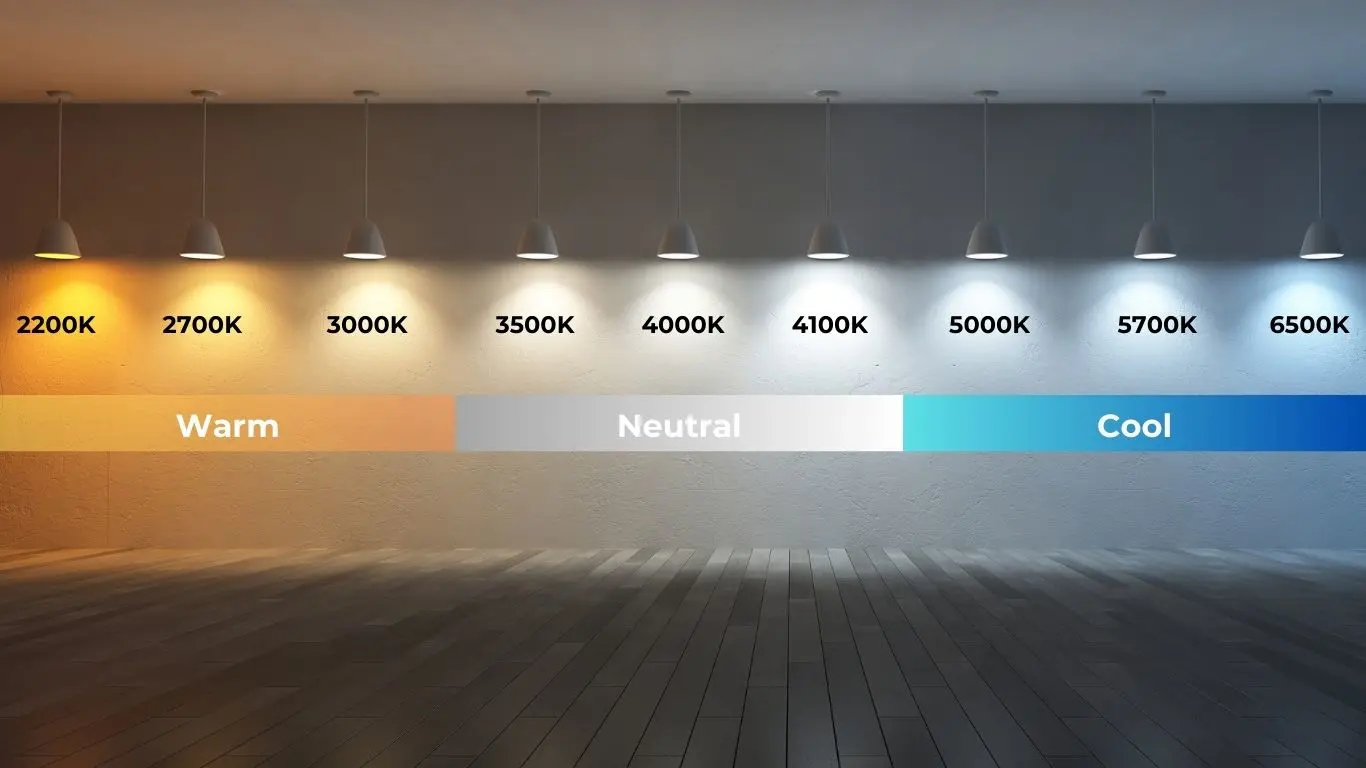In commercial lighting, the right lighting can make the difference in the functionality, aesthetics, and overall atmosphere of a space. Two factors the influence the quality of lighting are color temperature and color rendering index (CRI). Both factors determine how a light source will appear and how accurately it will render colors.
Color Temperature
What is Color Temperature?
Color temperature is measured in Kelvin (K) and describes the appearance of light. Color temperatures range from warm to cool tones with warm tones being more yellow in color and cool tones being bluer in color. The color temperature of lighting can affect both the mood and functionality of a space.
Warm White (2200K - 2700K)
Warm white lighting in the color temperatures range from 2200K to 2700K is a popular choice for hospitality environments, residential areas, and restaurants. Warmer tones create a cozy and inviting atmosphere that enhances the comfort and appeal of these spaces. Usually, warmer color temperatures are not normally used in commercial spaces unless it is in a comforting space like a dining area, lounge, or for accent lighting as the lighting is more to mimic the soft, amber glow of traditional incandescent bulbs or even candlelight.
Soft White (3000K)
Soft white lighting at 3000K is at the higher end of the warm spectrum and provides a slightly brighter and more neutral light compared to lower Kelvin color temperatures. It is often used for residential purposes in bathrooms and kitchens where a balance between both warmth and functionality is important. The 3000K soft white light maintains an inviting atmosphere but offers improved clarity and visibility. That makes the lighting suitable for both clarity and visibility for tasks while keeping the space feeling comfortable.
Neutral White (3500K - 4100K)
Neutral white lighting, ranging from 3500K to 4100K, is ideal for office and retail settings. It provides balanced illumination that supports clarity and focus, essential for productivity and effective visual display in these environments.
Daylight (5000K)
Daylight lighting at 5000K provides bright illumination that closely resembles natural daylight. This color temperature is ideal for offices, classrooms, and industrial work environments. In commercial settings, daylight lighting is often used to create clean and energizing atmospheres to promote productivity and attention to detail.
Cool White (6500K)
Cool white lighting, with a color temperature of 6500K is an intense, bluish light in color. It is commonly used in industrial settings, hospitals, and other task-oriented areas where safety and precision are required. This color temperature offers high visibility, which is crucial for safety, security, and concentration in these demanding applications. This color temperature is also chosen for outdoor lighting applications like parking lots for maximum visibility and its ability to light large spaces clearly.

Color Rendering Index (CRI)
What is CRI?
Color Rendering Index (CRI) measures how accurately a light source can display the true colors of objects compared to natural light, with a scale ranging from 0 to 100. The higher the CRI, the better the color accuracy.
CRI of Less than 80 (<80):
Lighting with a CRI of below 80 typically provides lower color accuracy and is commonly found in outdoor lighting and older lighting technologies. This lower CRI is often a trade-off to prioritize energy efficiency and cost-effectiveness, which is required for outdoor and large-scale lighting applications. Solar-powered fixtures and other outdoor LED area lights (like those used for parking lots) often have a CRI of around 70.
Older lighting technologies like High Pressure Sodium (HPS) bulbs and some fluorescent lights also have CRI ratings in the 70s or lower. This means that they do not render colors as accurate as LEDs. Outdoor environments including parking lots and street lighting that use LEDs with a CRI of around 70 may not show colors as vividly. But the lighting still provides adequate visibility and serves its purpose for safety and security.
CRI of 80-89:
This range is suitable for most commercial settings, providing good color accuracy that works well in offices, classrooms, and retail environments where general color accuracy is important but not critical.
CRI of 90+:
A CRI of 90 or higher is essential in settings where color precision is crucial, such as art galleries, design studios, and high-end retail spaces. In these environments, accurate color representation is key for aesthetic and functional reasons. For instance, in clothing stores, true-to-life colors help customers make better purchasing decisions. In healthcare facilities, high CRI lighting aids medical professionals in making more accurate assessments and diagnoses.
Why Color Temperature and CRI Matter in Commercial Lighting
Color temperature and CRI are important because they play a significant role in how a commercial space is used. The right color temperature sets the tone for a space and enhances the functionality and ambiance of a space. When an inappropriate color temperature is used, it can make a space feel both unwelcoming and less functional. An example of inappropriate color temperature usage would be a warm white light used in an industrial facility that needs cool white lighting for both safety and productivity.
High CRI lighting helps to reduce eye strain and improve visual comfort to perform tasks easier. Productivity is also boosted when the correct color temperature is chosen. CRI and color temperature are more than just another technical specification in LED lighting. They are metrics that can determine how functional, visually appealing, and comfortable a space becomes.
CCT Adjustable LED Lighting Fixtures
CCT adjustable LED lighting fixtures are available in many categories from flat panels and troffers to flood lights and canopy lights. These fixtures allow users to select between different color temperatures (with many having up to 5 color temperature options). This makes it easier to test different color temperatures within a space to find the right one. CCT adjustable LEDs provide flexibility and customization. This versatility is useful during renovations or in spaces where maybe the lighting needs may evolve over time. CCT lighting fixtures are multiple fixtures in one so you can save both time and money while ensuring that the lighting is functional for the space's atmosphere.
Top Products










